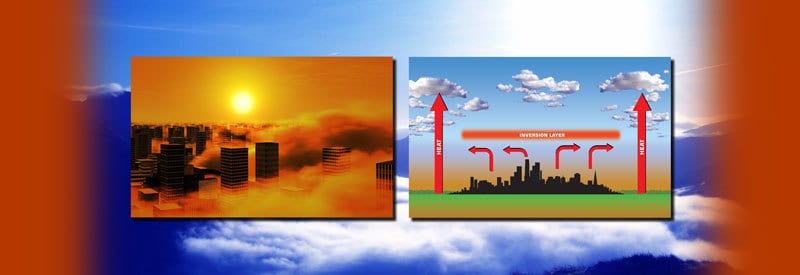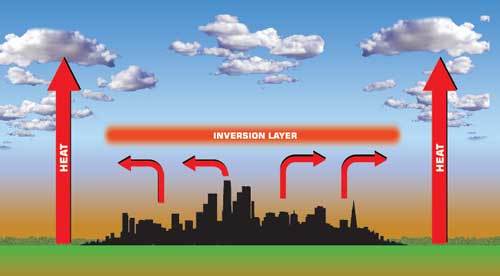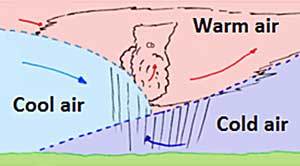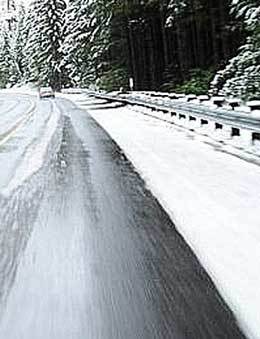Defining Temperature Inversion And How It Affects The Weather

As many of us have experienced, atmosphere temperatures typically drop as altitude increases above the Earth's surface. During an event known as temperature inversion, though, the exact opposite occurs.
Temperature Inversion is defined as the meteorological phenomenon that occurs when temperatures rise with an increase in altitude within a layer or pocket of air. This contrasts with the typical characteristics of the atmosphere, which usually exhibit a drop in temperature as altitude increases.
Temperatures continue to fall as altitude increases. It roughly drops by 9.8° Celsius every 1000 meters (5.4° Fahrenheit every 1 000 feet). Most of us experienced this occurrence at some point during our lives, when on the roof of a tall building or hiking up a mountain.
There is a phenomenon, however, that turns this norm on its head by causing an increase in temperature with height. It is called Temperature Inversion.
We take a closer look at what a temperature inversion is, what causes it, and its impact on the weather and environment.
Temperature Inversion Definition

Temperature Inversion can be defined as the meteorological phenomenon that occurs when temperatures rise as altitude increases within a layer of air. This contrasts with the typical characteristics of the atmosphere, which usually shows a drop in temperature as altitude increases.
This phenomenon can occur in a fixed position like the stratosphere, where the temperature naturally rises with height.
(The average temperature in the stratosphere starts at -51° Celsius (-60° Fahrenheit) above the troposphere, and rises to an average of -15° Celsius (5° Fahrenheit) close to the mesosphere.)
Temperature inversion also takes place in pockets or layers of air throughout the atmosphere caused by different variables. These layers are not so easily predictable and can have a dramatic impact on the weather and environment.
Causes And Types Of Temperature Inversion
This section will focus on the different variables that cause the inversion layers that appear randomly throughout the atmosphere. Temperature inversion is primarily caused by four different factors, resulting in four types of inversion:
1) Surface Inversion
This form of temperature inversion usually takes place on a cloudless night with little or no wind present, creating the perfect conditions for heat to escape rapidly from the surface.
As a result, the air at the surface cools down much more quickly than the air above it in the atmosphere, creating a low-lying temperature inversion.
2) Frontal Inversion
Colder air is denser and heavier than warmer air, which means a cold front is also heavier and thicker than a warm front.

When the two fronts meet, the lighter and warmer air from the warm front is lifted up by the cold and dense air from the cold front, resulting in warm air on top of a layer of cold air.
Unlike the other forms of temperature inversions, a frontal inversion takes place much higher up the atmosphere, as the size and steep gradient of the cold front allow the warmer air to be raised up to higher altitudes.
To find out more about warm and cold fronts and their characteristics, you can read more about them in this article.
3) Subsidence Inversion
This form of temperature inversion is a direct result of the pressure caused by huge masses of air. When these large volumes of air start to descend, it compresses the air within the layer, which leads to an increase in temperature.
It also has the added effect of slowing the speed at which temperature change takes place (lapse rate). If this layer of warm compressed air continues to descend, it causes the air higher up in the atmosphere to be warmer than the air closer to the surface.
4) Topography
The topography of the surface can also be responsible for the creation of a temperature inversion. A good example of this form of inversion is the one that takes place at night in the valley between hills or mountains.
When it cools down in the evening, the surface of the slopes on the hillside (or mountain peaks) cools down quicker than its surroundings, causing the air above it also to cool down. The colder air starts moving down the slopes and accumulates at the bottom of the valley.
As the colder air moves into the valley, it lifts the warmer air at the bottom up and away from the surface. This leaves the valley with colder air at the surface and warmer air higher up in the atmosphere.
The Effects Of Temperature Inversion
Due to the "unnatural" nature of temperature inversion, some unexpected and extreme conditions are created as a result of this phenomenon. Some of these results can be seen as potentially harmful and dangerous. The most important ones are:
1) Freezing Rain
Under normal conditions, when ice crystals combine to form snowflakes in subzero temperatures, it falls to the ground and stays intact as it falls through colder air as it nears the surface.
With an inversion layer present, though, the snow melts as it falls through the warmer air. When it exits the layer, it does not have enough time to freeze again, but the temperature in the raindrops continues to drop to below freezing point, creating supercooled water.

This is called freezing rain, and as soon as these cold raindrops hit the surface, they are immediately turned into ice. This is extremely dangerous, as the thin layer of ice that is formed is almost invisible and extremely slippery.
When this ice forms on the surface of roads or pavements where people walk, it makes these surfaces very slippery and almost impossible to spot. This is referred to as black ice and is a major cause of accidents on and off the road in countries frequently experiencing this weather phenomenon.
(Learn more about freezing rain and how it differs from sleet in this article.)
2) Sound Amplification
A temperature inversion also has the effect of amplifying sounds below it. It as acts as a giant reflective ceiling under which all sound generated is refracted down.
This means sounds can travel further and sound much louder than it really is. For example, it has been extensively reported that thunderstorms sound much louder when an inversion layer is present.
Man-made occurrences like the sound of a passenger aircraft, explosions, and other loud sounds appear to sound louder and can be heard further away.
3) Smog
Probably the most important and dangerous consequence of temperature inversion is the trapping of smog and other toxic gasses in a densely populated urban environment or metropolitan area.
Due to the infrastructure and the heat generated by transport and other human activities in a city, heat is absorbed and maintained, only to be slowly released in the atmosphere above the city at night and during cold winter months.

This creates a layer of temperature inversion covering the city. This inversion layer acts as a seal that traps smog, warm air, and other toxic emissions in the city.
This not only creates a serious environmental problem but also poses a dangerous and potentially life-threatening situation by keeping these gases from escaping and trapped on the surface and lower atmosphere.
Carbon dioxide, smog, carbon monoxide, and lead are just a few of the chemicals trapped below the inversion layer. All these chemicals have severe and long-term effects on human health and mortality.
You can read all about The Urban Heat Island effect, what causes it, and its effect on the weather and environment in this article.
Conclusion
After reading this post, you will have a much better understanding of what Temperature Inversion is and how it is bucking the trend of meteorological norms.
To be honest, though, as the weather is starting to show some startling and peculiar trends during recent years due to more than a hundred years of reckless human interference, it may not stand out as rebellious or unanticipated on its own for much longer.
For now, one needs to understand the causes and dangers of temperature inversion in order to make sure we prevent similar disruptive weather trends from getting established, expanding, and becoming the new norm.
Never miss out again when another interesting and helpful article is released and stay updated, while also receiving helpful tips & information by simply clicking on this link .
Until next time, keep your eye on the weather!
